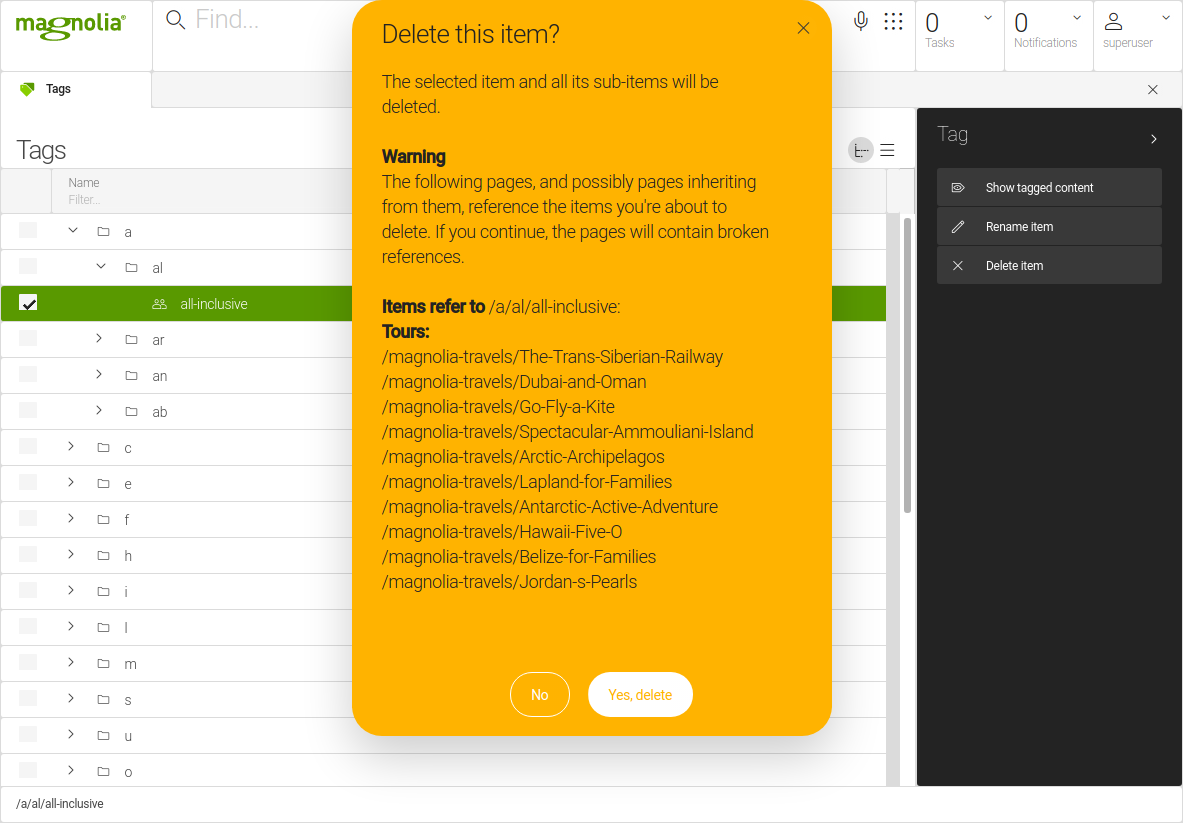How to enable content tags for a content app - 5 UI
Deprecated
|
This content tagging been deprecated since Magnolia 6.0. It is part of the Magnolia 5 UI framework. For the updated implementation, see How to enable content tags for a content app in Magnolia 6 UI instead. |
This page explains how to enable content tagging in a content app so that authors can add tags to content items.

The dx-core-demo-webapp contains an example of how to use the Content
Tags module. In this page, we show how the Tours app has been modified
to enable tagging for tours, and we also provide general instructions
and code samples showing how to enable tagging in other apps (Contacts
app example).
Make sure your bundle contains the
Content tags modules
(magnolia-content-tags-core and magnolia-content-tags-ui).
You can enable content tags in a new content app or in one that already exists. In the examples below, we modify existing apps using decoration. We assume that you are familiar with Magnolia content apps and Definition decoration.
Enabling tagging in content apps
Update the configuration of your content app subapps to enable content tagging.
You may also register the workspace in the configuration of the
content-tags module to ensure that dependencies are managed across
workspaces when you delete data.
Browser subapp
You must update your Browser subapp descriptor to be able to:
-
Add tags to existing content items.
-
Display applied tags.
-
Search content items by tag in the search view.

To do so:
-
Set the property
subAppClasstoinfo.magnolia.contenttags.shortcut.TagShortcutAwareBrowserSubApp. -
Add the action
info.magnolia.contenttags.dialog.OpenTagDialogActionDefinitionand make it available for the content items for which you want to enable tags.
If you give the action the nameaddTags, the system automatically provides a translation for the default language (English). If you are using a different name or if you want to change the default translation (Add tags), provide an i18n key. -
Make sure the views of the Workbench have columns to display the tags: on the view
searchset the propertyimplementationClasstoinfo.magnolia.contenttags.app.contenttool.search.TagSearchPresenter.
|
When decorating your content app later, make sure you select the proper node type in the decoration of the browser subapp. (See lines 12-13 in both examples below concerning the browser subapp.) And make sure you to use the proper node names in the action bar sections. (See lines 17-20 in both examples below concerning the browser subapp.) |
Detail subapp
You must update your Detail subapp descriptor so that authors can then add tags while creating or editing a content item.

To do so:
-
Add a field of type
info.magnolia.contenttags.form.field.TagFieldDefinition -
Add an action with the action class
info.magnolia.contenttags.form.action.SaveDialogWithTagsActionDefinition
|
When decorating your content app later, make sure you check the |
Configure content dependency in the content-tags configuration
This step is optional but recommended; it ensures JCR data sanity and improves user experience.
Add a configuration node for the workspace - the workspace used by the content app for the content items to which you add tags. This ensures, thas when you delete a tag from the Tags app, the system checks for occurrences of these tags on registered workspaces, it shows notifications about these occurrences and, if you agree, it removes references of the tags on content items in registered workspaces.

To enable this, add a node to
/modules/content-tags-core/config/taggableWorkspaces:

| Property | Description |
|---|---|
|
required The |
|
required An arbitrary name to register one taggable workspace. |
|
required Use the pattern |
|
required The name of the workspace of the content app. |
Examples
In both examples, we use decoration to adapt the subapps.
Definition decoration is a mechanism that allows you to change the properties and subdefinitions of an existing definition item.
Decoration is used to modify the existing tours app. The decoration is
applied by the module magnolia-travel-demo-content-tags (see the
Tours app example). As an additional example,
we have decorated the contacts app (see the
Contacts app example).
In addition to decorating the apps, we also adapt the content-tags
configuration to ensure that dependencies are managed across workspaces
when you delete data.
Tours app
The tours app is defined in the submodule magnolia-travel-tours
of the travel-demo module.
The travel demo module is bundled with various preconfigured Magnolia webapps and bundles.
The travel demo module for DX Core webapp comes with the submodule magnolia-travel-demo-content-tags.
This submodule decorates the Tours app.
Decoration of the browser subapp
/enterprise/travel-demo-content-tags/decorations/tours/apps/tours.subApps.browser.yaml
Contacts app
In this example, we enable tagging in the Contacts app. This example does not rely on the demo modules. Compare this example with the Tours app decoration example above – note that the decoration for the Contacts app is very similar.
Decoration of the browser subapp
/using-content-tags/decorations/contacts/apps/contacts.subApps.browser.yaml
Decoration of the detail subapp
/using-content-tags/decorations/contacts/apps/contacts.subApps.detail.yaml
Registering the contacts workspace in content-tags configuration

|
You can clone the Contacts app decoration from the repository. |
